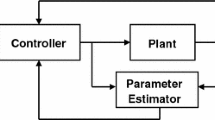Abstract
Hybrid simulation is an innovative method that combines an analysis model of a structural system with physical tests of one or more substructures. The analysis model is typically a finite element analysis (FEA) model that outputs displacements applied to the physical substructure using a control system operated in displacement control. For stiff specimens, the displacement commands can be so small that the control system has difficulty imposing the command displacements accurately. To do hybrid simulation with a stiff specimen, force control is desirable. Cascade control, which features two layers of closed loop control, is proposed to address this issue. The inner control loop has force control mode that provides accurate control for hybrid tests with stiff specimens. The outer control loop is in displacement control mode for accepting displacement commands from an FEA model. The effectiveness of the cascade control method in conducting hybrid simulation of stiff test specimens was evaluated with three sets of tests. For each set of tests, the results of both cascade control and displacement control methods were compared. The three test cases covered a wide range of variation from specimen size, test equipment, model type (2-D vs. 3-D), experimental element type (beam-column vs. truss), and test speed (slowdown 10 times in Test Case 1 and 2 versus 100 times in Test Case 3). In all cases, cascade control proved to be an effective method for conducting hybrid simulation with a stiff specimen.













Similar content being viewed by others
References
Schellenberg A, Mahin S (2006) Application of an experimental software framework to hybrid simulation of structures through collapse, In: First European Conf on Earthq Eng and Seismology 2006 (1st ECCS), Geneva, Switzerland, 3-8 Sept, vol 10, pp 6676–6685
McKenna F (1997) Object-oriented finite element programming: frameworks for analysis, algorithms and parallel computing. Ph.D. Thesis, University of California, Berkeley, CA, USA
Takahashi Y, Fenves GL (2006) Software framework for distributed experimental computational simulation of structural systems. Earthq Eng Struct Dyn 35(2):267–291
Ahmadizadeh M, Mosqueda G (2008) Hybrid simulation with improved operator-splitting integration using experimental tangent stiffness matrix estimation. J Struct Eng-ASCE 134(12):1829–1838
Pan P, Nakashima M, Tomofuji H (2005) Online test using displacement-force mixed control. Earthq Eng Struct Dyn 34(8):869–888
Hung C, El-Tawil S (2008) A method for estimating specimen tangent stiffness for hybrid simulation. Earthq Eng Struct Dyn 38(1):115–134
Scott MH, Fenves GL (2010) A krylov subspace accelerated Newton algorithm: application to dynamic progressive collapse simulation of frames. J Struc Eng 136(5):473–480
Brown PN, Saad Y (1990) Hybrid Krylov methods for nonlinear systems of equations. SIAM J Sci Comput (USA) 11:450–481
Kim H (2011) Development and implementation of advanced control methods for hybrid simulation Dynamics of Structures. PhD thesis, University of California, Berkeley
Nakata N, Spencer BF, Elnashai AS (2006) Mixed load/displacement control strategy for hybrid simulation. In: 4th Int. Conf. on Earthq Eng, Taipei, Taiwan, 12-13 Oct, Paper No. 094
Shing PSB, Mahin SA (1990) Experimental error effects in pseudodynamic testing. J Eng Mech-ASCE 116(4):805–821
Gao XS, You S (2019) Dynamical stability analysis of MDOF real-time hybrid system. Mech Syst Signal Process 133(1):106261. https://doi.org/10.1016/j.ymssp.2019.106261
Mirza Hessabi R, Mercan O (2012) Phase and amplitude error indices for error quantification in pseudodynamic testing. Earthq Eng Struct Dyn 41(10):1347–1364
Funding
None.
Author information
Authors and Affiliations
Corresponding author
Ethics declarations
Conflict of Interest
The authors declare no competing interests.
Additional information
Publisher's Note
Springer Nature remains neutral with regard to jurisdictional claims in published maps and institutional affiliations.
Rights and permissions
Springer Nature or its licensor (e.g. a society or other partner) holds exclusive rights to this article under a publishing agreement with the author(s) or other rightsholder(s); author self-archiving of the accepted manuscript version of this article is solely governed by the terms of such publishing agreement and applicable law.
About this article
Cite this article
You, S., Gao, X.S., Thoen, B. et al. Cascade Control Method for Conducting Hybrid Simulation with Stiff Specimens. Exp Tech (2023). https://doi.org/10.1007/s40799-023-00689-3
Received:
Accepted:
Published:
DOI: https://doi.org/10.1007/s40799-023-00689-3



